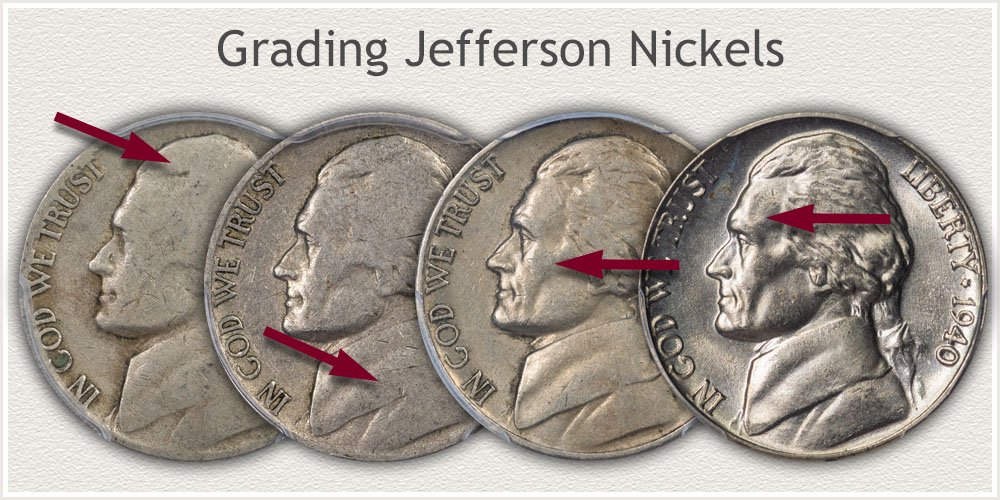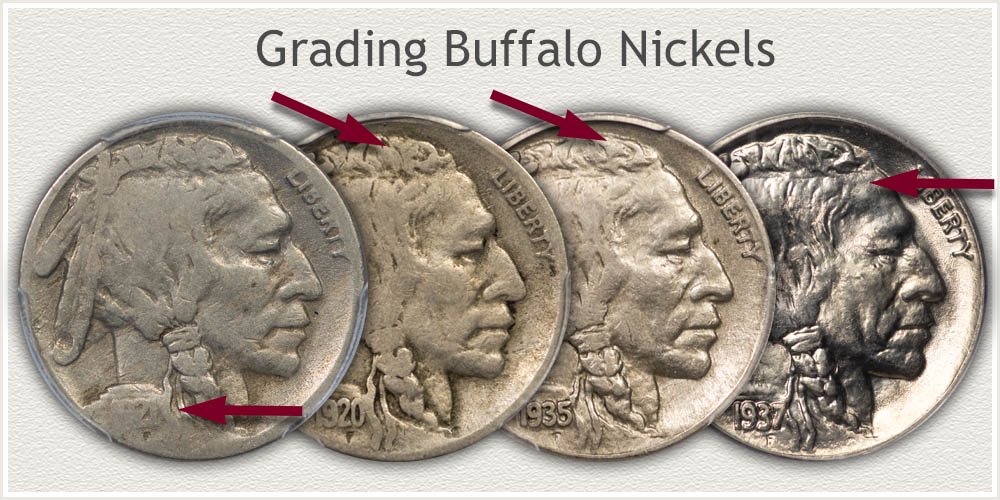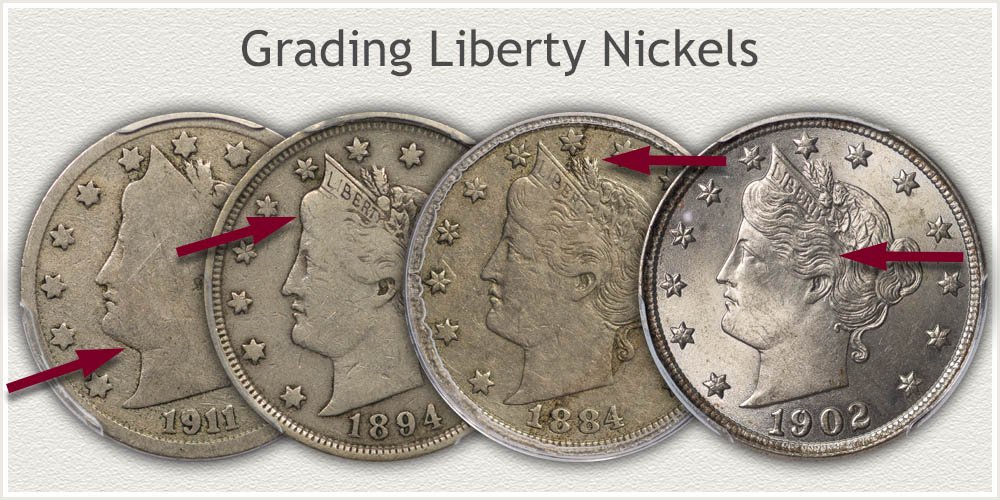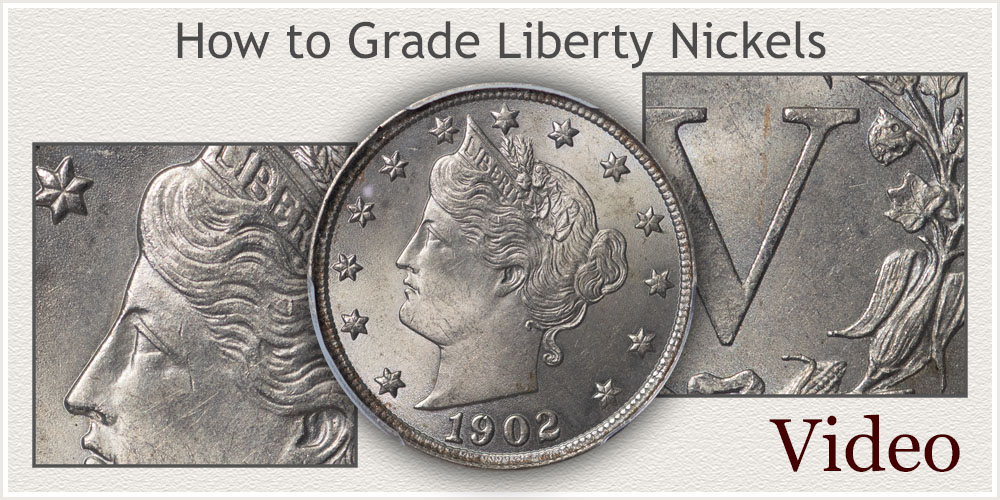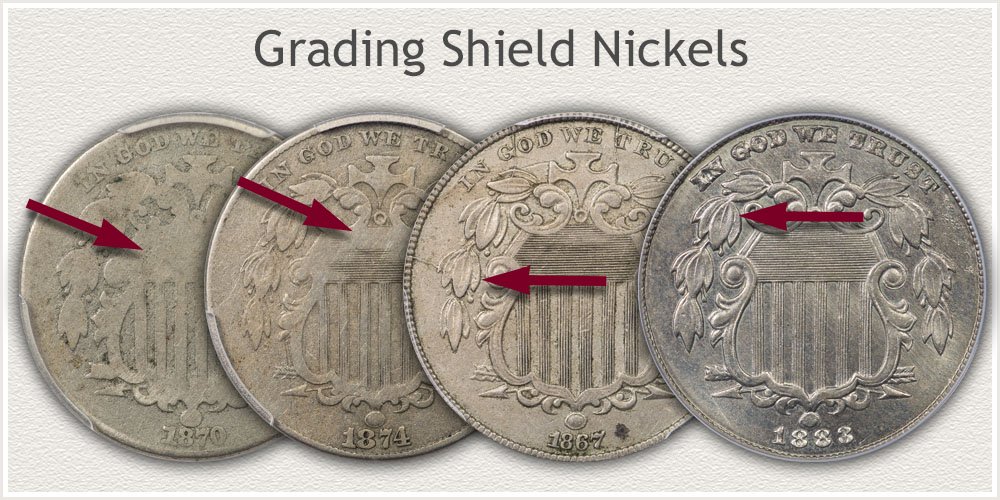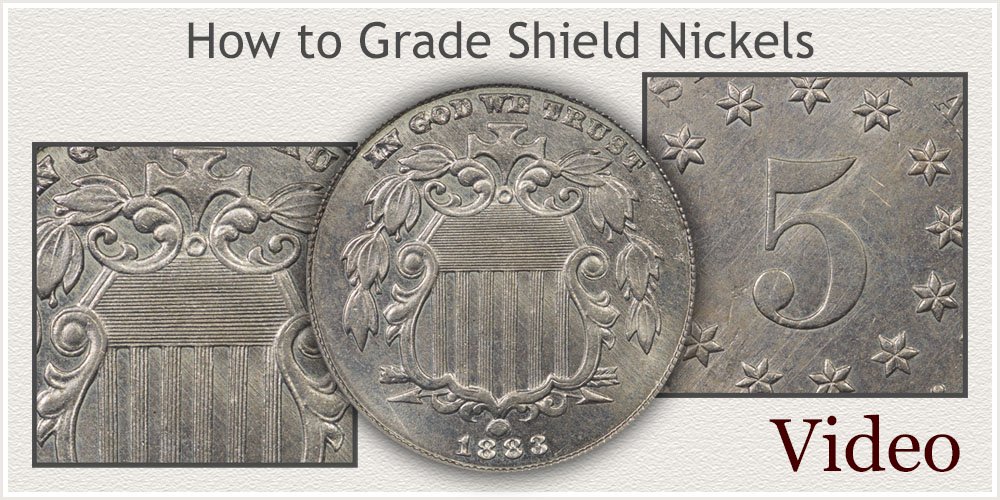Coin Values Moving with Precious Metals: Up-Dated 12/1/2025: Gold $4236 | Silver $56.79
How to Grade Old Nickels
Inspecting the surface of an old nickel and judging the amount of wear starts the grading process. Each level of condition is defined into a "grade." These grades then become an important part of a coin's description.
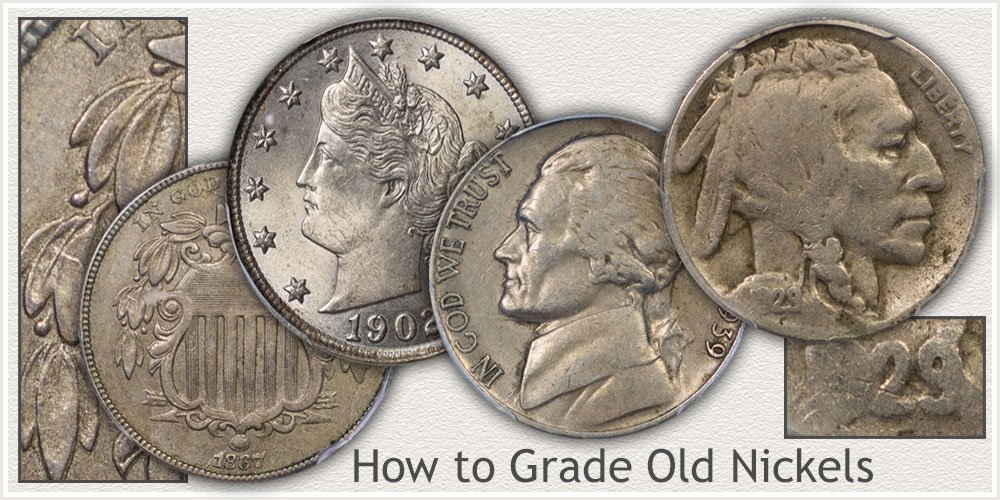 (fig. #1) Beginning the Comparison Method of Grading Old Nickels
(fig. #1) Beginning the Comparison Method of Grading Old Nickels
The above image (fig. #1) depicts the four major nickel series. Each different design has its own set of grading standards determining a specific grade. How to grade old nickels begins with a comparison method. Matching your coin to an example coin of a known grade narrows its condition range.
First | A Few Preparations
U.S. nickels are very durable, made of a 25% nickel to 75% copper alloy. When adding the smaller size, these coins wear slowly and retain details well. On each of the series, distinct wear patterns indicate grade levels.
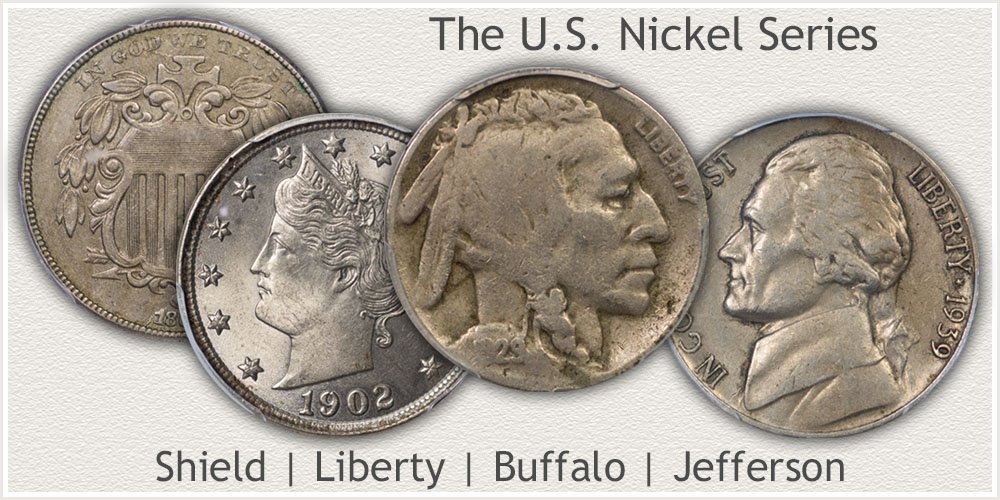 (fig. #2) Illustrated are Shield | Liberty | Buffalo | Jefferson Nickels
(fig. #2) Illustrated are Shield | Liberty | Buffalo | Jefferson Nickels
Grading condition takes into consideration the unique design elements of each nickel series (fig. #2).
Causing some difficulty when grading is the tendency of a soft strike affecting the sharpness of the design. This shows as weakness and lack of detail in small features. These soft areas began when the coin was first minted. Because nickel is difficult to strike into a coin, judging quality considers this when grading. Each series has areas often found weakly struck.
Set up a work space with an open area and a single light source. A magnifying glass helps focus and enlarge the small areas of a coin's surface. The single light casts strong shadows needed to bring out subtle, almost flat, worn areas. A basic approach keeps your back to outside ambient light, with the lamp just above the subject coin.
The Grades | Overview
A coin in Mint State condition illustrates all detail in full display. Examining complete and original detail is a good start to the grading process.
Mint State Grade
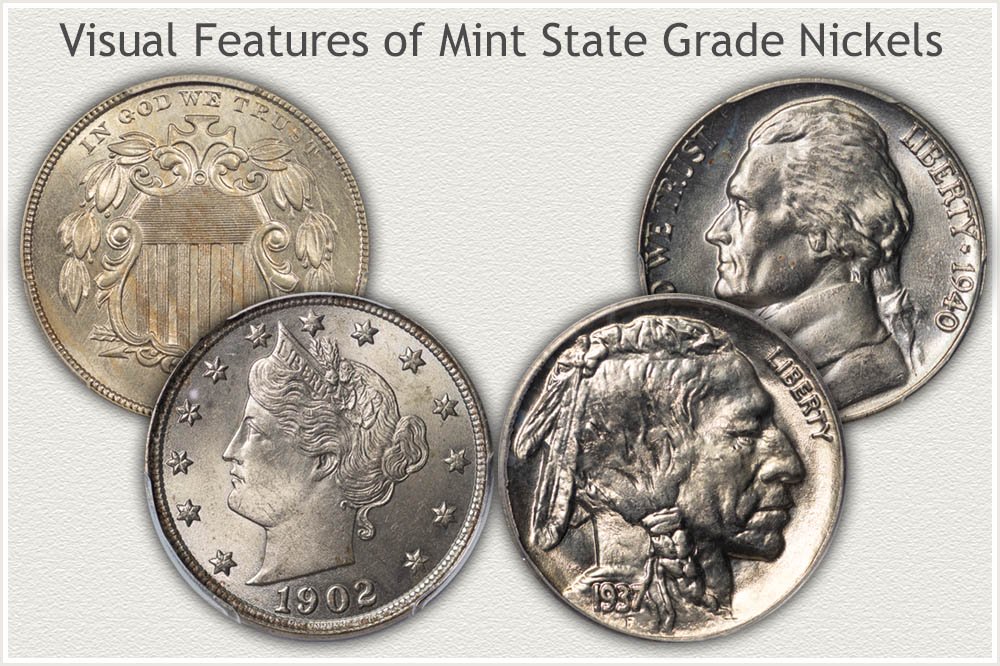 (fig. #3) Compare to the Mint State Grade Visual Features of the Nickel Series
(fig. #3) Compare to the Mint State Grade Visual Features of the Nickel Series
The fundamental definition of Mint State grade is a coin without any wear to its surface. These are the top-quality coins, avidly sought by collectors. Luster, the shine of the coin, is a key indicator of wear. Recognizing complete luster covering the highest points of the design identifies the grade. Worn metal looses luster and becomes a dull, muted gray color.
Shield Nickel: Inspect all raised ridge areas of the cross located above the shield. Near the horizontal lines, high point of the shield's frame are prone to wear quickly. Confirm all show luster.
Liberty Nickel: Liberty's hair strands and cheek are the focal points determining if the surface is free of wear. A textured metal surface indicates no wear. Smooth metal, especially along the top edges of hair strands, indicates wear.
Buffalo Nickel: Matching metal texture and shine along high points and low recesses helps confirm a "no-wear" surface. The design features of this series have fewer fine points to inspect. A close examination of the metal confirming an original surface remains without smoothing. Focus on high contours, hair, neck, and eyebrow.
Jefferson Nickel: A bold portrait shows many areas of high and low relief. Confirm complete luster over the coat and collar, and further up, within Jefferson's hair. Dulling of the metal in these areas indicates worn metal.
Extremely Fine Grade
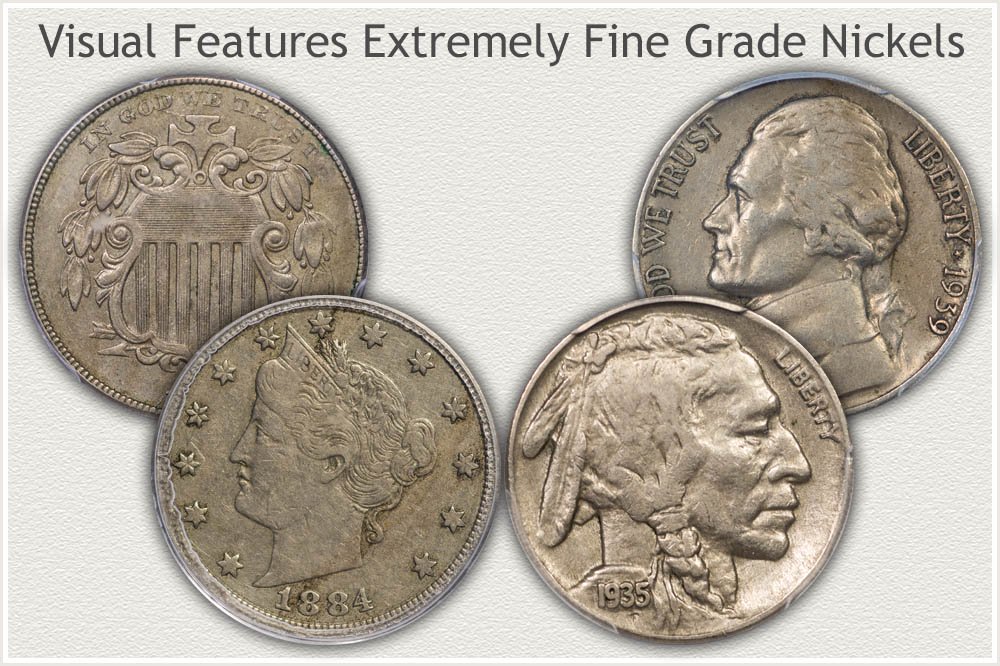 (fig #4) Compare to the Visual Features of Nickels in Extremely Fine Grade
(fig #4) Compare to the Visual Features of Nickels in Extremely Fine Grade
When a coin's surface displays only light wear it is in a highly collectible condition. Light wear is the general classification of the Extremely Fine grade. Notably, a Shield nickel is scarce in lightly circulated condition.
Shield Nickel: Focus on the leaves to judge this light wear requirement. The leaf edges exhibit a slight flattening and smoothness at their tips.
Liberty Nickel: A quick starting place to grade is the letters of "Liberty" within her headband. All letters visible and clear indicate the Extremely Fine grade quality. Confirm the condition by only light smoothness of her cheek.
Buffalo Nickel: Compare to the image the small amount of wear on the cheek area. A light amount of wear also shows as a small flattening of metal below the eye.
Jefferson Nickel: Examine Jefferson's cheek and forehead. This avoids areas of potential weakness in the strike. Light wear flattens high contours just below and above his eye. To meet the grade standard, no flatness from above to below the eye connects.
Fine Grade
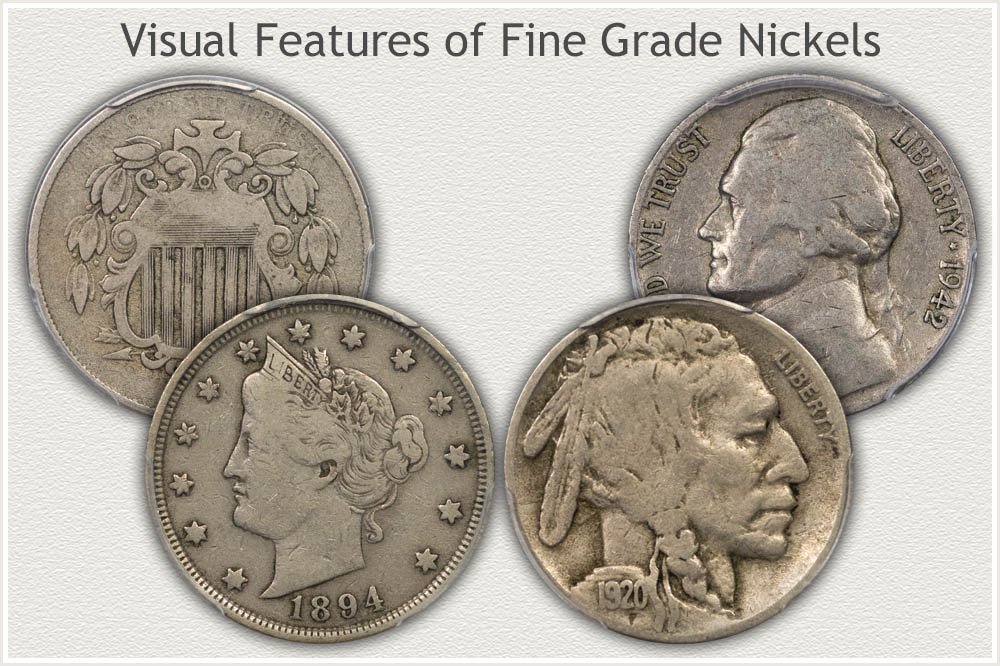 (fig. #5) Visual Features of the Four Nickel Series in Fine Grade
(fig. #5) Visual Features of the Four Nickel Series in Fine Grade
Once a nickel displays noticeable areas of flatness, moderate wear defines the condition. This becomes the general description of the Fine grade. One important quality requires a certain degree of fine detail remaining. Recognizing these small areas of sharpness is key when grading old nickels.
Shield Nickel: Moderate wear along the upper edge begins to flatten and partially fade the motto "In God We Trust." Second indication of the grade is the faded condition of a few leaves on either side of the shield.
Liberty Nickel: Small details remaining in Liberty's hair become the focal point. Some areas of detailed hair strands next to flat areas help recognize the condition. More than half of the hair features show fine line recesses.
Buffalo Nickel: Two areas display deep recesses of detail. There is still visible detail within the hair above the braid. Secondly, the braid itself shows separation between the binding.
Jefferson Nickel: A subtle grading point indicates the Fine grade Jefferson nickel. Next to the eye area, Jefferson's hairline shows faintly. A small rise in metal contour indicating the hairline remains.
Good Grade
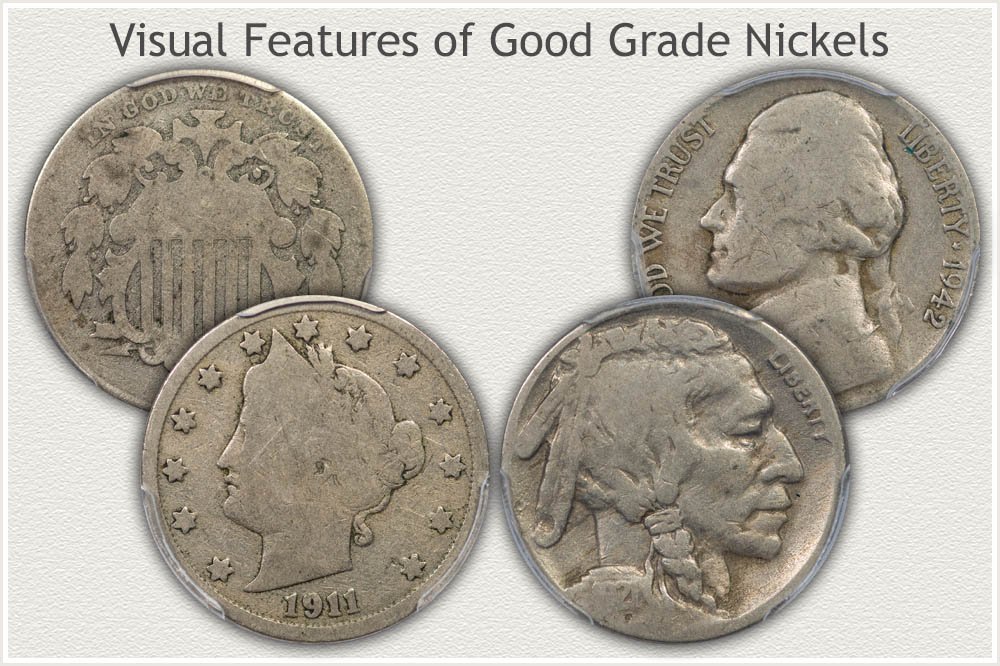 (fig. #6) The Four Nickel Series Displaying Visual Good Grade Features
(fig. #6) The Four Nickel Series Displaying Visual Good Grade Features
First impression of an old nickel in Good grade is the amount of heavy wear. Large areas of the coin's surface lack any detail. A certain degree of blending of design elements becomes noticeable. However, major features remain clear.
Shield Nickel: Notice the illustration the shield. Most lettering, and specifically the date, remain visible and readable. Wear removes only the inner fine design.
Liberty Nickel: A flat, smooth Liberty portrait indicates the Good grade. The stars and date are also flattened without raised contours. Key to the grade level, none of these major elements blend into the field of the coin.
Buffalo Nickel: A weak date, hard to read, identifies the Good grade. The date area displays few details, often with the first two digits - 19 - hard to detect. Another trait, the letters of "Liberty" blending with the rim, helps recognize the grade.
Jefferson Nickel: Jefferson's forehead and hair combine into one flattened areas. Lack of detail with the folds of his coat defines the heavy wear condition.
This overview of the grades and their appearance begins to illustrate recognizable traits. Comparing your coin to graded examples helps recognize categories of wear. This develops the skill to quickly separate different conditions. How to grade old nickels starts with this first level of judgment. Wear develops in distinct patterns within each nickel series.
A Focus on How to Grade Each Nickel Series
A closer and specific study of each nickel series refines the comparison approach to grading. Each series, covered in detail, inspects the many variables of a coin's condition applying grading standards.
Detailed descriptions, with images and video, visually identify the different grades. You then use these to grade each series of old nickels.
Visual Grading Guides
Jefferson NickelsHow to Grade Jefferson Nickels
An emphasis on the Mint State grade and determining wear separates the higher value coins. Jefferson nickels date back to 1938, with these early years now strictly graded.
Buffalo Nickels
The high relief design of this important series requires very close inspection. Details of the date's visibility starts the inspection of key grading features.
Liberty Nickels
Details abound on the Liberty series of nickels. Wear patterns present the visual clues defining each grade. The noticeable details combined with the subtle details decide condition levels.
How to Grade Liberty Nickels Video
With this video, continue the grading of Liberty nickels to a higher degree of accuracy. Follow the process of determining the surface condition of these coins and the requirements to meet each grade level.
Shield Nickels
This first series of U.S. nickels represents scarce coinage and a grading challenge. The smallest of details often decide the grade level. This translates into major value changes.
How to Grade Shield Nickels Video
Compare your coin to a series of professionally graded examples of Shield Nickels. Matching key features helps decide on a grade range.
Condition of a coin is one part of many forming a complete description of a coin. How to grade old nickels starts at the overall inspection level. Next, a close evaluation of each series improves the accuracy of its description.
Placing a value on the nickel now relies on additional steps of evaluation. As with the grading process, each nickel series is unique, and specific qualities contribute to an accurate assessment.
How to Grade Old Coins || Visual Grading Guides
Visit the complete listing of grading guides specific to each coin series. A comparison method discovers the many subtle points. How to grade old coins becomes a visual guide when presented through videos, images, and detailed descriptions.
References
Finance U.S. Senate. Coinage Laws United States 1792 to 1894
https://archive.org/details/coinagelawsofuni1894comm/page/828/mode/2up
Coin Values | CoinStudy Articles
By determining the condition of a coin accomplishes an important factor of its value. Continue by following a step-by-step approach and discover how much these old nickels are worth.
Shield Nickel Value | Condition and Grade Determine Worth
Shield nickels are a scarce series of coins. After determining the grade, next, the date and special qualities highlight the value to collectors. Proceed through defined steps and complete the description of your coin.
The Value of V Nickels | Many Scarce to Rare
Liberty nickels have a strong following among collectors. Depending on the date and grade combination, these old nickels are worth high premiums.
Buffalo Nickel Value | Popular and Strong Values
Buffalo nickels are a popular coin series. Value now depends on dates, specific mint marks, and the important consideration of condition.
Jefferson Nickel Values | High Condition Equals High Value
The Jefferson series of nickels shows the early era with solid values. Many of these first-year issues are now collected in circulated condition. The silver nickel years are all worth premiums because of their precious metal content.
★Coin Values Discovery pulls together... How to Grade Old Nickels and...
All US coin values. Shield nickels show a wide range of values. Value charts of these nickels and all series of coins discover their worth.
